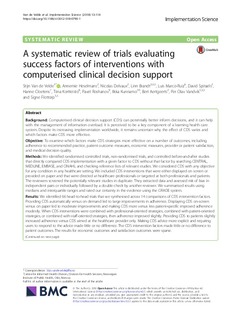| dc.contributor.author | van de Velde, Stijn Rita Patrick | |
| dc.contributor.author | Heselmans, Annemie | |
| dc.contributor.author | Delvaux, Nicolas | |
| dc.contributor.author | Brandt, Linn | |
| dc.contributor.author | Marco-Ruiz, Luis | |
| dc.contributor.author | Spitaels, David | |
| dc.contributor.author | Cloetens, Hanne | |
| dc.contributor.author | Kortteisto, Tiina | |
| dc.contributor.author | Roshanov, Pavel | |
| dc.contributor.author | Kunnamo, Ilkka | |
| dc.contributor.author | Aertgeerts, Bert | |
| dc.contributor.author | Vandvik, Per Olav | |
| dc.contributor.author | Flottorp, Signe Agnes | |
| dc.date.accessioned | 2018-09-20T11:23:01Z | |
| dc.date.available | 2018-09-20T11:23:01Z | |
| dc.date.created | 2018-09-06T13:02:29Z | |
| dc.date.issued | 2018 | |
| dc.identifier.citation | Implementation Science. 2018, 13 . | |
| dc.identifier.issn | 1748-5908 | |
| dc.identifier.uri | http://hdl.handle.net/11250/2563649 | |
| dc.description.abstract | BACKGROUND:
Computerised clinical decision support (CDS) can potentially better inform decisions, and it can help with the management of information overload. It is perceived to be a key component of a learning health care system. Despite its increasing implementation worldwide, it remains uncertain why the effect of CDS varies and which factors make CDS more effective.
OBJECTIVE:
To examine which factors make CDS strategies more effective on a number of outcomes, including adherence to recommended practice, patient outcome measures, economic measures, provider or patient satisfaction, and medical decision quality.
METHODS:
We identified randomised controlled trials, non-randomised trials, and controlled before-and-after studies that directly compared CDS implementation with a given factor to CDS without that factor by searching CENTRAL, MEDLINE, EMBASE, and CINAHL and checking reference lists of relevant studies. We considered CDS with any objective for any condition in any healthcare setting. We included CDS interventions that were either displayed on screen or provided on paper and that were directed at healthcare professionals or targeted at both professionals and patients. The reviewers screened the potentially relevant studies in duplicate. They extracted data and assessed risk of bias in independent pairs or individually followed by a double check by another reviewer. We summarised results using medians and interquartile ranges and rated our certainty in the evidence using the GRADE system.
RESULTS:
We identified 66 head-to-head trials that we synthesised across 14 comparisons of CDS intervention factors. Providing CDS automatically versus on demand led to large improvements in adherence. Displaying CDS on-screen versus on paper led to moderate improvements and making CDS more versus less patient-specific improved adherence modestly. When CDS interventions were combined with professional-oriented strategies, combined with patient-oriented strategies, or combined with staff-oriented strategies, then adherence improved slightly. Providing CDS to patients slightly increased adherence versus CDS aimed at the healthcare provider only. Making CDS advice more explicit and requiring users to respond to the advice made little or no difference. The CDS intervention factors made little or no difference to patient outcomes. The results for economic outcomes and satisfaction outcomes were sparse.
CONCLUSION:
Multiple factors may affect the success of CDS interventions. CDS may be more effective when the advice is provided automatically and displayed on-screen and when the suggestions are more patient-specific. CDS interventions combined with other strategies probably also improves adherence. Providing CDS directly to patients may also positively affect adherence. The certainty of the evidence was low to moderate for all factors.
TRIAL REGISTRATION:
PROSPERO, CRD42016033738. | en |
| dc.description.sponsorship | This project has received funding from EU’s Horizon 2020 research and innovation programme under the Marie Sklodowska-Curie grant agreement no 654981. The funder was not involved in any parts of the research. | en |
| dc.language.iso | eng | en |
| dc.publisher | BMC Springer Nature | |
| dc.relation.uri | https://implementationscience.biomedcentral.com/track/pdf/10.1186/s13012-018-0790-1 | |
| dc.rights | Navngivelse-Ikkekommersiell-DelPåSammeVilkår 4.0 Internasjonal | * |
| dc.rights.uri | http://creativecommons.org/licenses/by-nc-sa/4.0/deed.no | * |
| dc.subject | Clinical computerised decision support systems; Evidence-based medicine; Guideline adherence; Implementation; Practice guidelines; Systematic review | en |
| dc.title | A systematic review of trials evaluating success factors of interventions with computerised clinical decision support | en |
| dc.title.alternative | A systematic review of trials evaluating success factors of interventions with computerised clinical decision support | en |
| dc.type | Peer reviewed | en |
| dc.type | Journal article | en |
| dc.description.version | publishedVersion | en |
| dc.rights.holder | © The Author(s). 2018 Open Access This article is distributed under the terms of the Creative Commons Attribution 4.0 International License (http://creativecommons.org/licenses/by/4.0/), which permits unrestricted use, distribution, and reproduction in any medium, provided you give appropriate credit to the original author(s) and the source, provide a link to the Creative Commons license, and indicate if changes were made. The Creative Commons Public Domain Dedication waiver (http://creativecommons.org/publicdomain/zero/1.0/) applies to the data made available in this article, unless otherwise stated. | |
| dc.source.pagenumber | 11 | nb_NO |
| dc.source.volume | 13 | nb_NO |
| dc.source.journal | Implementation Science | |
| dc.identifier.doi | 10.1186/s13012-018-0790-1 | |
| dc.identifier.cristin | 1607289 | |
| cristin.unitcode | 1991,3,0,0 | |
| cristin.unitname | Div Gjøvik | |
| cristin.ispublished | true | |
| cristin.fulltext | original | |
| cristin.qualitycode | 1 | |

